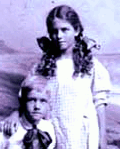

To understand Margaret Mead one has to look at her beginnings. Her parents met at University of Chicago. Her father, Edward Sherwood Mead, would become a professor at the University of Pennsylvania. Her mother, Emily Fogg Mead, would become a sociologist and an early advocate of women’s rights. Coming from a background of highly motivated parents gave Margaret a head start in the world.
Margaret was born in Philadelphia, Pennsylvania on December 16, 1901. She was born in a hospital rather than at home. Her brother Richard came along in 1903. Her father would call her “Punk” and her brother would be called “punk-boy”. Katherine was the first of three sisters. Born in 1907 she died nine months later. Elizabeth was born in 1909 and Priscilla was born in 1911. Priscilla would die in 1959.
Edward Mead was on the faculty of the Wharton School of Finance, which meant a steady stream of fellow professors and students came and went from the Mead house. Margaret would listen and take note of practical terms and how businesses grew and prospered. Emily Mead had issues to defend but felt strongly about the family she was raising. Her graduate work was suspended for years while the family grew and grew up.
In 1919 Margaret enrolled in DePauw University. She discovered too late that college for her roommates meant pledging a sorority. When she didn’t pledge she found most students wouldn’t even talk to her. She had come to college as an extension of the education she had at home and found the social aspect of the school disheartening. She directed a play with an all girl cast and eventually pitted the sororities against each other to get another non-pledged girl elected to class vice-president.
Margaret studied history, ethics and writing and found the course work more satisfying and a good foundation for the work she would do in the future.
In 1920 Margaret persuaded her father to allow her to transfer to Barnard College. She was closer to home and closer to Luther Cressman, to whom she was engaged. With dormitory space a problem, Margaret and some other students took an apartment on West 116th Street. In her senior year Margaret took a class on Anthropology from Frank Boaz, a visiting professor from Columbia University. She was writing a psychology paper and planning on a master’s program in psychology, but; took other classes from Boaz in the spring.
In 1923 Margaret became a college graduate and a new bride. She married Luther Cressman and began to study anthropology at Columbia University under Boaz. She kept her own name despite the unconventionality of such an act. Luther and Margaret had a small apartment while she continued her studies with Boaz, which she would complete in 1925. Fieldwork was the next item on her agenda. She wanted to study an old culture. Although Boaz wanted her to study adolescence, Margaret was determined to see a culture without the influence of the culture she knew here in America. They compromised. Margaret Mead studied adolescence in an old culture, Samoa.
Margaret went to Samoa and Luther to Europe. They would divorce in 1928.
In the coming years there would be two more husbands, Reo Fortune in 1928 divorced 1934 and Gregory Bateson, married 1936 and divorced 1951. Her daughter, Mary Catherine Bateson was born in December 1939. Film was becoming an important medium and Margaret would embrace it as a way to illustrate her work. She would revisit her islands and would change the way fieldwork was done. Her influence over future anthropologists would be a lasting legacy. She became the curator of the American Museum of Natural History and would join the staff of Columbia University.
Fieldwork in the islands and the study of culture in many parts of the world brought her recognition and controversy. Her ideas were revised and criticized. She would speak out on issues about the preservation of the earth and the culture of women and families.
Designed by: Heather Rodriguez, Mary Barzelay & David Spencer